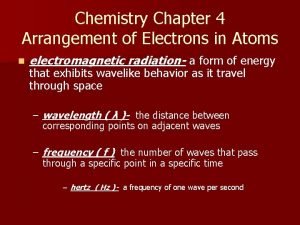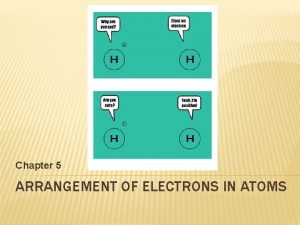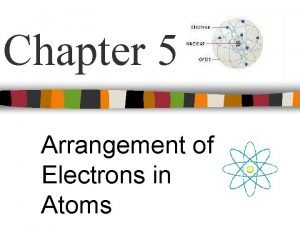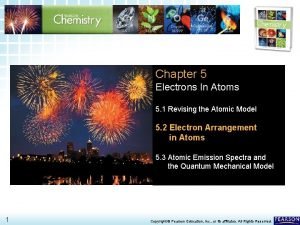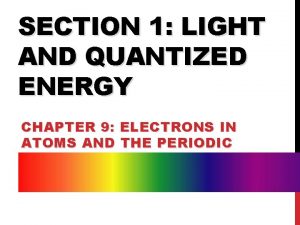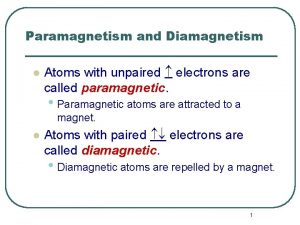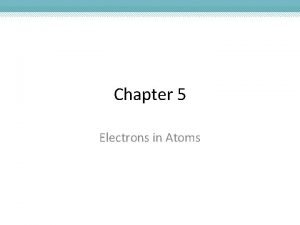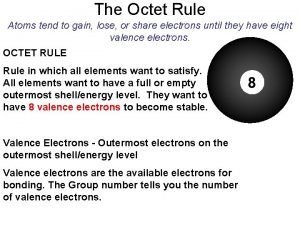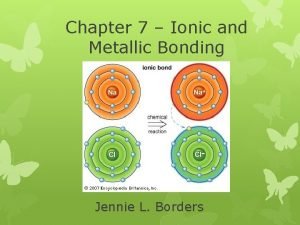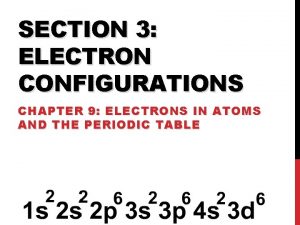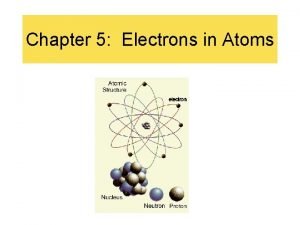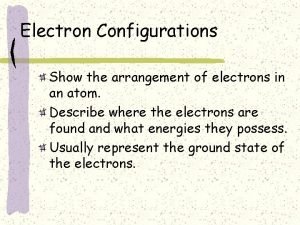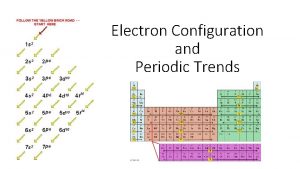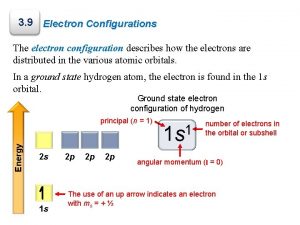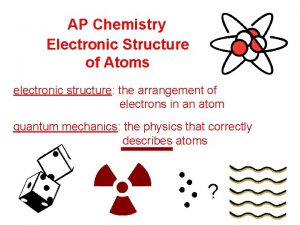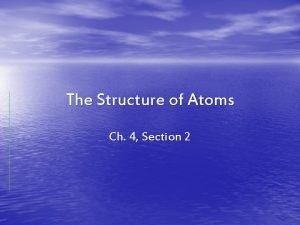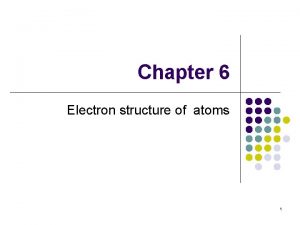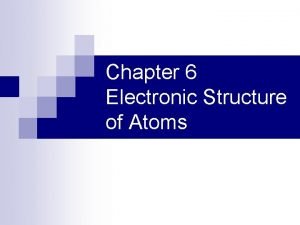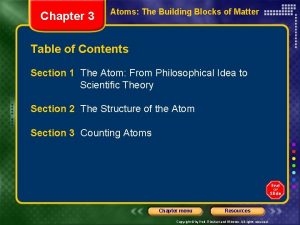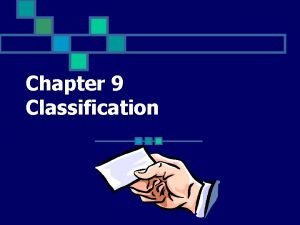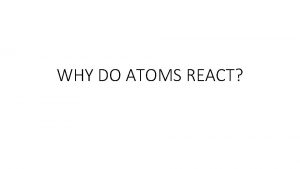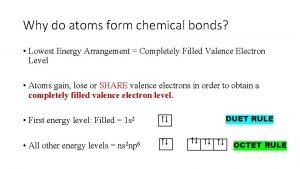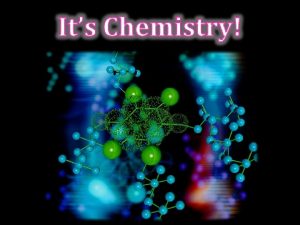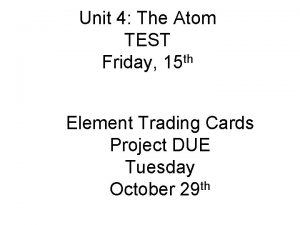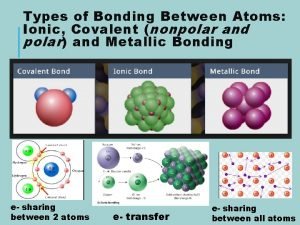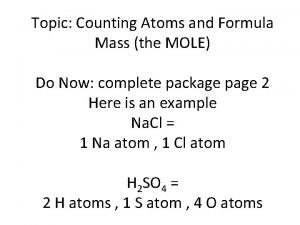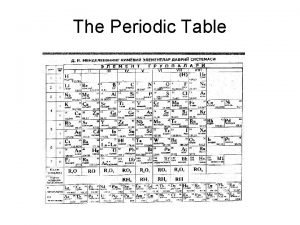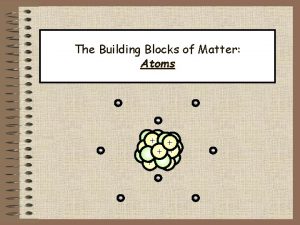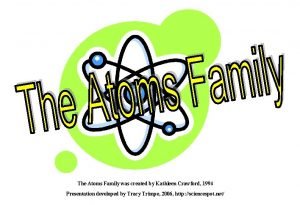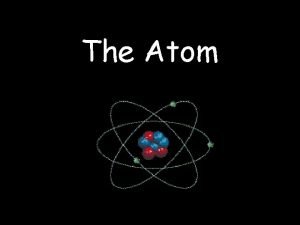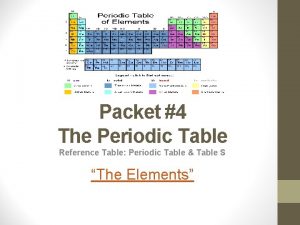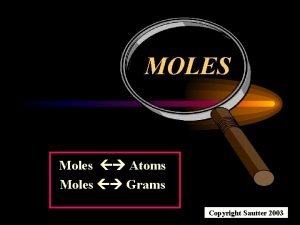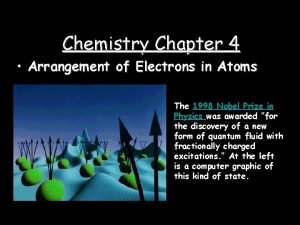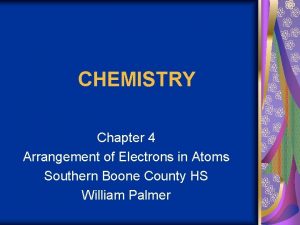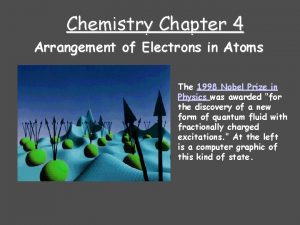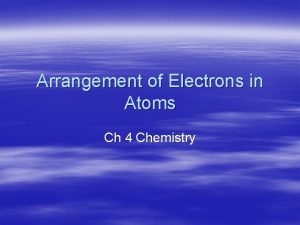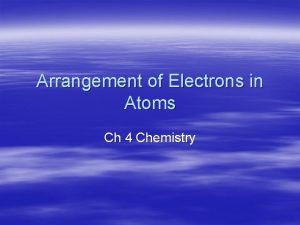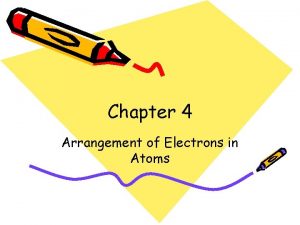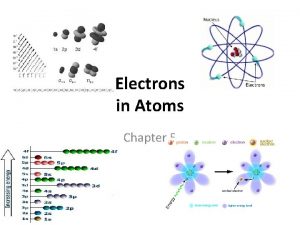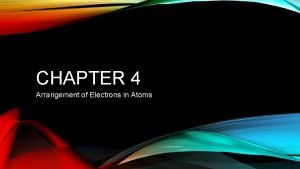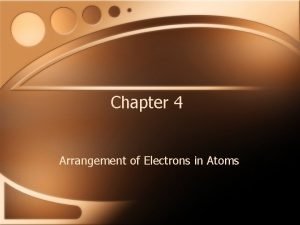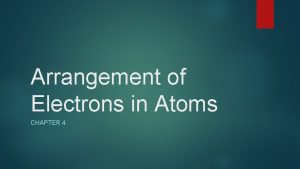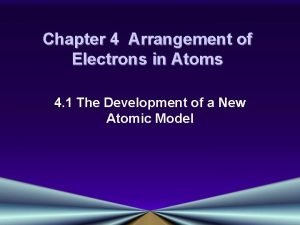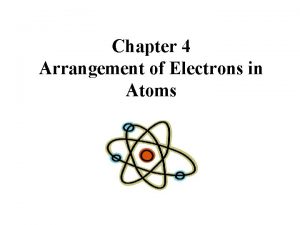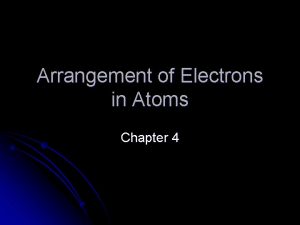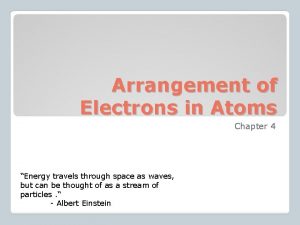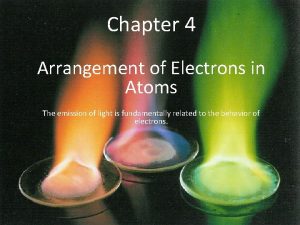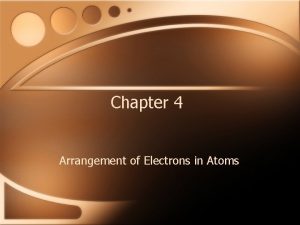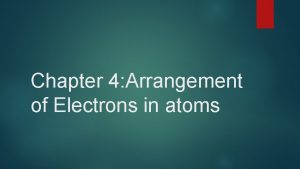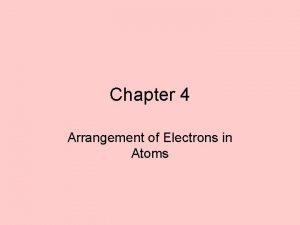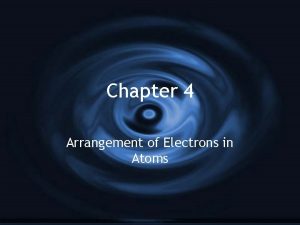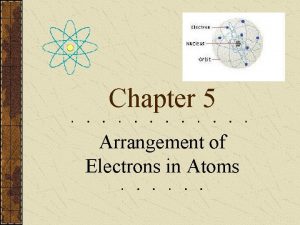CHEMISTRY Chapter 4 Arrangement of Electrons in Atoms

















































- Slides: 49

CHEMISTRY Chapter 4 Arrangement of Electrons in Atoms Southern Boone County HS William Palmer

CHEMISTRY CHAPTER 4 Properties of Light Electromagnetic Radiation Wavelike behavior Visible light X-Rays Ultraviolet Infrared

CHEMISTRY CHAPTER 4

CHEMISTRY CHAPTER 4 Wavelength-Distance between corresponding parts of a wave (lambda) Frequency-Number of waves that pass a point in a given time (v). Measured in hertz (HZ)

CHEMISTRY CHAPTER 4 c is speed of light 186, 000 miles/sec frequency X wavelength = speed of light c=f λ λ =c/f f=c/ λ So what? As wavelength increases, frequency decreases As wavelength decreases, frequency increases

CHEMISTRY CHAPTER 4 Photoelectric Effect -emission of electrons when a light shines on a metal.

CHEMISTRY CHAPTER 4 Photoelectric Effect -emission of electrons when a light shines on a metal. Light must be of a high frequency. Hard to explain with wave theory of light.

CHEMISTRY CHAPTER 4 Max Planck (1900) Objects emit light in small packets called quanta. The Quantum Theory

CHEMISTRY CHAPTER 4 Quantum of energy is the smallest amount of energy that can be lost or gained by an atom.

CHEMISTRY CHAPTER 4 Einstein (1905) Electromagnetic radiation has a dual wave-particle nature! WOW

CHEMISTRY CHAPTER 4 HYDROGEN ATOM LINE-EMISSION SPECTRUM (WOW THAT IS A MOUTHFUL) What does it mean?

CHEMISTRY CHAPTER 4 What does it mean? When a current is passed through a gas light is emitted. In hydrogen gas, some of the light is lost-not in spectrum. This indicates that a specific amount of energy from the light was absorbed by the atom.

CHEMISTRY CHAPTER 4 Neils Bohr (1913) Electrons in orbits Different electrons have different energy levels (like rungs on a stepladder) When in orbit an electron has constant energy When electron goes to a higher energy state it moves up the ladder (absorption) When electron goes to a lower energy state it moves down the ladder (emission)

CHEMISTRY CHAPTER 4 Questions 1 -5 page 103 Try questions 1 -3, page 110 PPT not ready yet…

CHEMISTRY CHAPTER 4, sec 2 HEISENBURG UNCERTAINY PRINCIPLE-It is hard to tell the location of an electron. Or…. in formal words….

CHEMISTRY CHAPTER 4, sec 2 HEISENBURG UNCERTAINY PRINCIPLEIt is impossible to simultaneously tell the position and velocity of an electron or other particle. You can tell one but not the other.

CHEMISTRY CHAPTER 4, sec 2 QUANTUM NUMBERS AND QUANTUM ORBITALS Quantum numbers specify the properties of atomic orbitals and the properties of electrons in orbitals.

CHEMISTRY CHAPTER 4, sec 2 PRINCIPAL QUANTUM NUMBER (n) Main energy level occupied by an electron. Positive integers 1, 2, 3, 4 ….

CHEMISTRY CHAPTER 4, sec 2 AS n INCREASES, THE ELECTRON’S ENERGY AND DISTANCE FROM THE NUCLEUS INCREASE.

CHEMISTRY CHAPTER 4, sec 2 So, which has more energyquantum number 4 or quantum number 6? Which is closer to the nucleus of the atom?

CHEMISTRY CHAPTER 4, sec 2 There are four types of Quantum Numbers: 1) Main Quantum Number 2) Angular Momentum Quantum Number 3) Magnetic Quantum Number 4)Spin Quantum Number

CHEMISTRY CHAPTER 4, sec 2 Angular Momentum Quantum Number (l)-Indicates the shape of the orbit.

CHEMISTRY CHAPTER 4, sec 2 S ORBITALS

CHEMISTRY CHAPTER 4, sec 2 P ORBITALS

CHEMISTRY CHAPTER 4, sec 2 D ORBITALS

CHEMISTRY CHAPTER 4, sec 2 F ORBITALS

CHEMISTRY CHAPTER 4, sec 2 Magnetic Quantum Number (m)Indicates the orientation of the orbit around the nucleus.

CHEMISTRY CHAPTER 4, sec 2 Spin Quantum Number (-1/2, +1/2) -Indicates the fundamental spin state of the electrons of the orbit around the nucleus.

CHEMISTRY CHAPTER 4, sec 2 s = sphere p = dumbbell d= complex dumbbell f=very complex shape

CHEMISTRY CHAPTER 4, sec 2 PRINCIPAL QUANTUM NUMBER (n) SUBLEVELS IN MAIN ENERGY LEVEL ORBITALS PER SUBLEVEL ORBITALS PER ENERGY LEVEL ELECTRONS PER SUBLEVEL ELECTRONS PER MAIN ENERGY LEVEL 1 S 1 1 2 2 2 S 1 4 2 8 2 P 3 4 6 8 3 S 1 9 2 18 3 P 3 9 6 18 3 D 5 9 10 18 4 S 1 16 2 32 4 P 3 16 6 32 4 D 5 16 10 32 4 F 7 16 15 32

CHEMISTRY CHAPTER 4, sec 2 Try questions 1 -3, page 110

CHEMISTRY CHAPTER 4, sec 3 Electron Configuration The goal of this section is to figure out how electrons are arranged in an atom. There are three rules.

CHEMISTRY CHAPTER 4, sec 3 Electron Configuration Rule 1: Aufbau Principle-an electron occupies the lowest energy orbital that can receive it.

CHEMISTRY CHAPTER 4, sec 3 Electron Configuration Rule 2: Pauli Exclusion Principle. No two electrons can have the same set of quantum numbers.

CHEMISTRY CHAPTER 4, sec 3 Electron Configuration Rule 3: Hund’s Rule –Orbitals of equal energy are each occupied by one electron before any orbital is occupied by a second electron.

CHEMISTRY CHAPTER 4, sec 3 Sample Problem The electron configuration of Boron is 1 s 22 p 1. How many electrons are present in an atom of Boron? (2+2+1 = 5 electrons) What is the atomic number of Boron? (protons = electrons so with 5 electrons there are 5 protons so Atomic No. of Boron = 5)

CHEMISTRY CHAPTER 4, sec 3 Sample Problem The electron configuration of Boron is 1 s 22 p 1. Write the orbital notation for Boron. ↑↓ ↑↓ ↑ 1 s 2 s 2 p

CHEMISTRY CHAPTER 4, sec 3 Practice Problem The electron configuration of Nitrogen is 1 s 22 p 3. How many electrons are in Nitrogen? 2. What is the atomic number of Nitrogen? 3. Write the orbital notation for Nitrogen. 1.

CHEMISTRY CHAPTER 4, sec 3 Practice Problem The electron configuration of Fluorine is 1 s 22 p 5. How many electrons are in Fluorine? 2. What is the atomic number of Fluorine? 3. Write the orbital notation for Fluorine. 1.

CHEMISTRY CHAPTER 4, sec 3 Second Period Elements See chart page 116 Third Period Elements See chart page 117 Fourth Period Elements See chart on page 118 FIGURE 19, PAGE 116, IS WHERE YOU LEARN HOW THE ELECTRONS FILL THE ORBITALS

CHEMISTRY CHAPTER 4, sec 3 Second Period Elements See chart page 116 Third Period Elements See chart page 117 Fourth Period Elements See chart on page 118 FIGURE 19, PAGE 116, IS WHERE YOU LEARN HOW THE ELECTRONS FILL THE ORBITALS

CHEMISTRY CHAPTER 4, sec 3 FIGURE 19, PAGE 116, IS WHERE YOU LEARN HOW THE ELECTRONS FILL THE ORBITALS

CHEMISTRY CHAPTER 4, sec 3 Sample Problem Write the electron configuration for a Rubidium atom. (Atomic Number = 37) 1 s 22 p 63 s 23 p 63 d 104 s 24 p 65 s 1 Write the Noble-gas configuration for Rubidium. [Kr] 5 s 1

CHEMISTRY CHAPTER 4, sec 3 Sample Problem Identify the elements in the second, third, and fourth periods that have the same number of highest energy level electrons as Rubidium has one electron in its highest energy level…(the 5 th). Other elements that have one electron in their highest energy level are: Li, Na, and K.

CHEMISTRY CHAPTER 4, sec 3 Practice Problem Write the electron configuration and Noble gas notation for a Barium atom. (Atomic Number = 56) 1 s 22 p 63 s 23 p 63 d 104 s 24 p 64 d 105 s 25 p 66 s 2

CHEMISTRY CHAPTER 4, sec 3 Practice Problem Write the electron configuration and Noble gas notation for a Barium atom. (Atomic Number = 56) 1 s 22 s 2 p 63 s 23 p 63 d 104 s 24 p 64 d 105 s 25 p 66 s 2 [Xe] 6 s 2

CHEMISTRY CHAPTER 4, sec 3 Practice Problem Write the Noble gas notation for a Gold atom. (Atomic Number = 79) 1 s 22 s 2 p 63 s 23 p 63 d 104 s 24 p 64 d 105 s 25 p 66 s 2 [Xe] 4 f 145 d 106 p 1

CHEMISTRY CHAPTER 4, sec 3 Practice Problem Identify the elements in the sixth period that have one unpaired electron in their 6 s level. Au, Cs, Pt

CHEMISTRY CHAPTER 4, sec 3 Practice Problem Let’s try the work sheet on Chap 4, sec 3.
 Arrangement of electrons in atoms chapter 4 test
Arrangement of electrons in atoms chapter 4 test Chapter 5 review arrangement of electrons in atoms
Chapter 5 review arrangement of electrons in atoms Chapter 5 electrons in atoms
Chapter 5 electrons in atoms Chapter 5 arrangement of electrons
Chapter 5 arrangement of electrons Chapter 5 arrangement of electrons
Chapter 5 arrangement of electrons At stp which substance is the best conductor of electricity
At stp which substance is the best conductor of electricity Electrons in atoms section 1 light and quantized energy
Electrons in atoms section 1 light and quantized energy Atoms with 4 valence electrons
Atoms with 4 valence electrons Diamagnetic elements
Diamagnetic elements Proton electron neutron
Proton electron neutron Electrons in atoms section 1 light and quantized energy
Electrons in atoms section 1 light and quantized energy Electrons in atoms section 2 quantum theory and the atom
Electrons in atoms section 2 quantum theory and the atom Electrons in atoms section 2 quantum theory and the atom
Electrons in atoms section 2 quantum theory and the atom Octet rule
Octet rule How do chemists model the valence electrons of metal atoms?
How do chemists model the valence electrons of metal atoms? How do chemists model the valence electrons of metal atoms?
How do chemists model the valence electrons of metal atoms? Electrons configurations
Electrons configurations 5 electrons in atoms
5 electrons in atoms Unstable arrangement of atoms
Unstable arrangement of atoms Electronic configuration is arrangement of electrons in
Electronic configuration is arrangement of electrons in التوزيع الالكتروني
التوزيع الالكتروني What are electron configurations
What are electron configurations Ap chemistry electronic structure of atoms
Ap chemistry electronic structure of atoms Ib organic chemistry
Ib organic chemistry Inorganic chemistry vs organic chemistry
Inorganic chemistry vs organic chemistry Chapter 4 section 2 the structure of atoms answer key
Chapter 4 section 2 the structure of atoms answer key Chemistry in biology section 2 chemical reactions
Chemistry in biology section 2 chemical reactions Chapter 6 electronic structure of atoms answers
Chapter 6 electronic structure of atoms answers Chapter 6 section 1 atoms elements and compounds
Chapter 6 section 1 atoms elements and compounds Chapter 6 electronic structure of atoms
Chapter 6 electronic structure of atoms Chapter 3 atoms the building blocks of matter
Chapter 3 atoms the building blocks of matter Chapter 3 atoms the building blocks of matter
Chapter 3 atoms the building blocks of matter Chapter 2 atoms molecules and ions
Chapter 2 atoms molecules and ions Most general to most specific classification
Most general to most specific classification Atoms want
Atoms want Dot ans
Dot ans What is the relationship between atoms and elements
What is the relationship between atoms and elements What are atoms?
What are atoms? Kesler science answer key
Kesler science answer key Matterville answer key
Matterville answer key Electronegativity trend
Electronegativity trend Gfm formula
Gfm formula Atoms in increasing size
Atoms in increasing size The smallest building block of matter
The smallest building block of matter The atoms family atomic math challenge
The atoms family atomic math challenge Whats a nucleus
Whats a nucleus Group 16 period 6
Group 16 period 6 How to find mols from grams
How to find mols from grams Amu vs molar mass
Amu vs molar mass Metallic bond occurs between
Metallic bond occurs between
